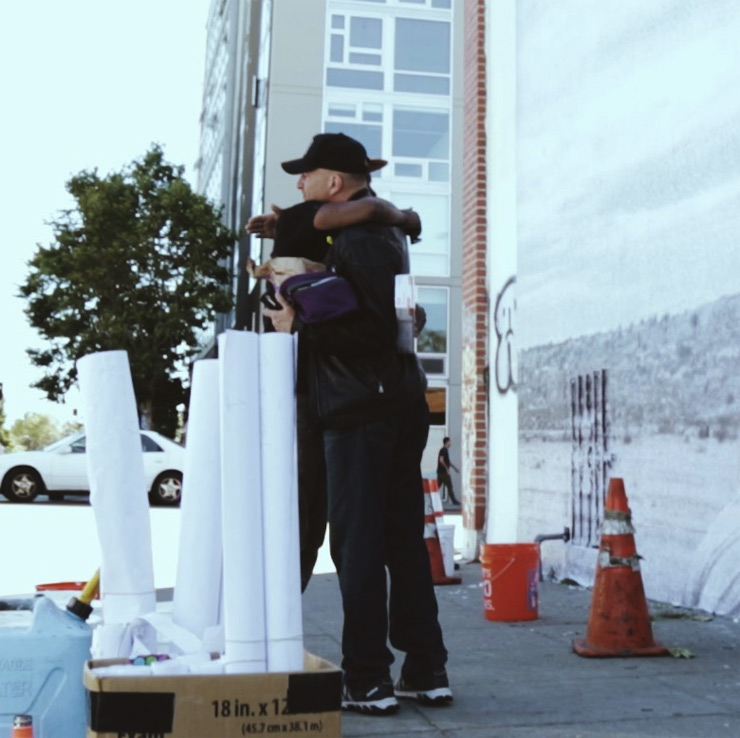An upside down American flag and a Navajo baby flying through the air.
The two images appear in this new wheatpasted project from Street Artist/Activist Chip Thomas in Oakland California for American Domain, the inaugural exhibition that opened June 17 at the Museum of Capitalism.

Chip Thomas with a photo of Dan Budnik from 1983 in the Navajo Nation. Oakland, CA. June 2017 (photo © Chip Thomas)
Mr. Thomas says that he was inspired to use this image when reading about the philosophical underpinnings for the show from Erin Elder, who is part of the curatorial collective that organized the show and who asked Thomas to “consider submitting work for a pop up show critically evaluating land use in a capitalist economy,” he tells us.
While an artist could possibly take this charge in a number of directions, he returned to the Navajo and Hopi people and their 130+ year land dispute, specifically a 1984 forced relocation of 9,000 Navajo tribal members. The irony of native peoples fighting over land is not lost on Mr. Thomas, who traces the concept of ownership to the European invaders of North America.
Elder explains of her American Domain show within the inaugural group show which includes artists such as Dread Scott, Jennifer Dalton, Futurefarmers, and Packard Jennings,“…Under capitalism, land is measured, marked, bounded, guarded, and owned; it is a commodity, a site of production, and oftentimes, capitalism’s dumping ground. Though land ownership is not an inherently American phenomenon, the United States was founded on a land grab and its identity has been consistently wrapped up with the economics of territory. Through artists’ work about fences and walls, boundaries and their trespass, American Domain examines notions of property and ownership.”

Chip Thomas with a photo of Dan Budnik from 1983 in the Navajo Nation. A man is seen walking in front of the mural on his way to the recycling center near by. Oakland, CA. June 2017 (photo © Chip Thomas).
This wall in particular now has this 1983 photo from a demonstration over the Navajo/Hopi dispute taken by photographer Dan Budnick that evokes the feelings of chaos, rootlessness, and rage that characterized the fight about territory. It also may remind some of the many who could not adjust to the relocation and losing their tribal ways and who became homeless over time.
“Dan’s images from his time at Big Mountain immediately came to mind,” says the Street Artist when he was conjuring an idea for a public wall addressing the exhibition theme. “I approached Dan about using one of his images for an installation and found him to be excited by the idea. Next I sought out a part time resident of Big Mountain whose mother was active in the relocation resistance. We agreed that, in light of the ongoing struggles of First Nations people to maintain sovereignty over their land, this image is as timely now as it was when it was taken in 1983,” says Thomas.

Chip Thomas with a photo of Dan Budnik from 1983 in the Navajo Nation. Oakland, CA. June 2017 (photo © Chip Thomas)

Chip Thomas. Oakland, CA. June 2017 (photo © Claudia Escobar)
Addendum from Chip Thomas:
The United States Flag Code
Title 4, Chapter 1
The flag should never be displayed with the union down, except as a signal of dire distress in instances of extreme danger to life or property.
Installing the image over a week in Oakland led to several insightful moments such as the police officer who pointed out the flag was upside down as he passed in his cruiser or the fireman who stopped his firetruck, got out and engaged me in conversation about the photo. The most compelling interaction was with a vet who vehemently proclaimed one evening while I was on the lift that he fought for that flag and didn’t appreciate seeing it upside down. He concluded by saying “Trump 2017!”

Chip Thomas. Oakland, CA. June 2017 (photo © Claudia Escobar)
Two days later he returned and shared that after 8 years of combat in Afghanistan seeing things no one should ever see he now suffers from PTSD, sleeps poorly and can’t hold a job. Things set him off easily and he has trouble controlling his emotions. He said he’d gone into service believing in this country and it’s promise of democracy both here and abroad only to realize he’d wasted 8 years of his life and is a changed man. He apologized for his aggressive tone 2 days earlier and cried as he recounted some of his life experiences. I thanked him for returning and providing an opportunity for discussion. We shook hands and embraced before he headed on his way.
Other Articles You May Like from BSA:
Happy March! With the brutally frigid temperatures we had for the whole month of February it is no small wonder that we can still find fresh new pieces on the streets. Some are weeks old and oth...
Jim Bachor puts his mosaics in potholes. It is unusual for sure. Even absurd. When it comes to the topic of ephemeral art, absurdity is part of the street art game. Jim Bachor (photo © John Dom...
The Italian street art interventionist named Fra. Biancoshock loves to reinvent space – especially public space. Biancoshock. "Cannot - 2022". Lodi, Italy. (photo © Biancoshock) Always on the l...
One on One with WK People are fascinated and even in love with “Street Art” now, and that fact has certainly not escaped WK Interact. The brutal traffic and the construction noise common in New Yor...
Let’s be fools in love, shall we? Let’s be exuberant in our love for this city, this life, this opportunity. Life only happens once. Let’s fall in love with it. Happy Valentine’s Day to the wh...
 BROOKLYN STREET ART LOVES YOU MORE EVERY DAY
BROOKLYN STREET ART LOVES YOU MORE EVERY DAY










